This comprehensive guide on how to approach the net in tennis covers tactics, technique of the approach shots, most effective footwork patterns, and the right timing to hit the ball.
Hitting effective topspin forehand or backhand slice approach shots is a very rewarding strategy if you execute it well, but there are quite a few nuances that you have to get right in order to have a high success rate at the net.
So let’s start first with tactics so that you know in which direction to approach and where to aim, and then we’ll go into more detailed instruction on how to execute the approach shots well.
1. How To Approach The Net With Smart Tactics
There are two main mistakes tennis players make when it comes to approaching the net in terms of tactics:
- they hit the approach shots in the wrong direction
- they usually aim too close to the sidelines, which results in many errors
a) Cross Court vs Down The Line
I overlayed both the cross court and down the line approaches into the same video from the moment I hit the ball to the moment my assistant Kaja hits the passing shot.

Here's how approaching cross court vs down the line looks like graphically.
When we draw the lines from her contact point to the possible angles that she can hit (down the line and cross court), we can then also draw the dashed line in the middle of those two angles.
And then we can also draw a circle that represents our ideal position at the net where we cover all angles equally well.
As you can see, I am much further from that ideal position at the net when I am approaching cross court than when I am approaching down the line.

And this is the difference in how well you cover the net based on the direction of your approach.
That’s why in most cases, it’s much better to approach down the line rather than with a cross court approach shot.
Coming to the net after a down the line shot gives you much better coverage at the net and often forces your opponent to go for too much on the passing shot since they see very little space around you.
b) Smart Target Area
Tennis players tend to aim too close to the lines when they approach the net because they assume they have that kind of accuracy with the shots (even though they keep making unforced errors).
The reality is that even at the highest level of tennis, players cannot hit with very high consistency a target area that is less than 2 meters (6 feet) wide.
At the recreational level, we can aim at around the same area width since we hit much slower balls than the pros, and that allows us to maintain some degree of accuracy.
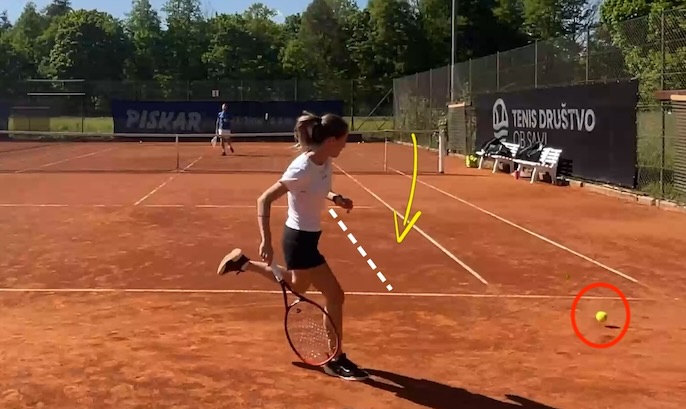
You'll miss most of your approach shots if you aim into such a small target area.
When I attempted shots into around a 1-meter wide area (3 feet), I hit around 50% of the shots in.
That is a very low percentage to hit when one has a short ball to attack and the opponent on the run. You are basically gifting them 50% of the points.
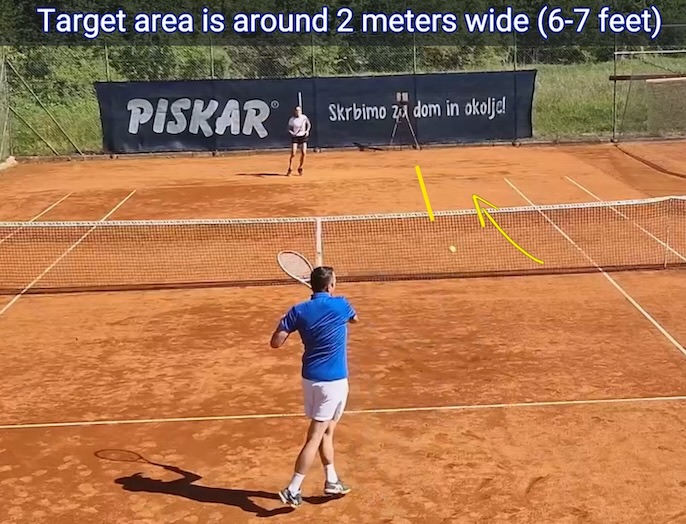
This 2 meter wide area gives you enough margin to make very few unforced errors.
Your guideline should be 90% of the shots hit into the 2-meter / 6-feet wide area and then cover the net well, and you’ll still win way over 50% of the points on short balls even though your opponent may pass you here and there.
2. Forehand Approach Shot Technique
You’re probably going to hit more forehand approach shots than backhand ones because most of you are right-handed. You’ll likely target your opponent’s backhands, which are weaker.
And that means you’ll likely be hitting a forehand down-the-line approach shot after you’ve stretched them wide.
I explained in one of the previous approach-related videos how to create a situation that gives you a very high success rate; you can check it out below.
Tennis players often face two common challenges when executing forehand approach shots:
- They hit the ball too flat, which increases the risk of unforced errors.
- They hit the ball with excessive topspin, resulting in a short, slow ball that makes it easier for the opponent to pass them.

Hitting flat approach shots is not going to end well in the long term.

And hitting with too much topspin will not put pressure on the opponent.
The key to hitting a forehand approach shot that has power and still some topspin, which helps to bring the ball down on the court, is to just “graze” the ball with topspin.
You can visualize “grazing” the ball with topspin like this:
- Swing at the ball with the racket as if you wanted to hit it flat.
- But then imagine hitting just an area at around 10:30 o’clock (where 9 o’clock is facing you and it would mean hitting the ball flat at the back and 12 o’clock would be the top of the ball) and spin the ball partially there.

Imagine just a slight arc on this ball as you aim it above the net.
I suggest you attempt that at a very low speed first where you drop the ball to yourself like you see me demonstrate in the video, and gently and slowly hit the ball in a way that I describe.
Once you get the hang of it, gradually increase the speed and look to maintain good control of the ball.
With regular practice, you will be able to accelerate much faster at the ball and still be able to hit it with this type of spin which preserves most of the ball’s speed, which is what you want when you hit approach shots on the forehand side.
3. Approach Shot Footwork Patterns
There are two main goals when it comes to the approach shot footwork patterns:
- The footwork needs to help you move quickly towards the net.
- The footwork pattern needs to allow you to hit very accurate shots.
The problem that recreational tennis players face is over-rotating their body as they hit the ball, and that happens on both the forehand and the backhand side.
While we have to hit open stance forehands sometimes when approaching the net, it’s better to hit neutral stance forehands as that allows us to swing in a more linear manner towards the target, which improves our accuracy.

Open stance forehands are not very accurate but you'll have to use them on higher balls.
So do the best you can to take care of your footwork as you are about to hit an approach shot with the forehand and try to align into a neutral stance.
You may also need to hop from the front leg onto the same leg while you are keeping your body more sideways for the short moment of hitting the ball, as that helps you hit more accurate shots.
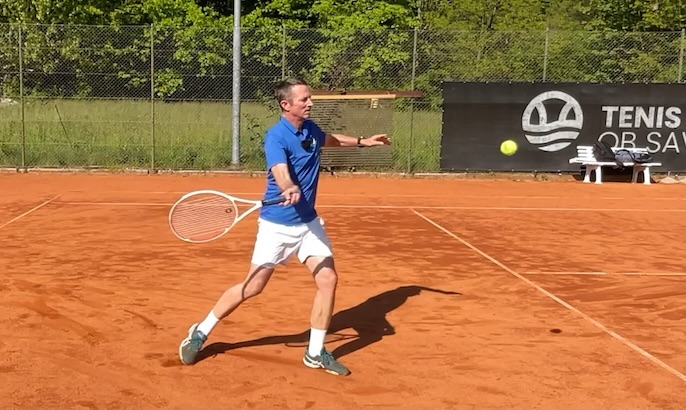
If you have time to position and the ball is lower, get into a neutral stance.
When it comes to backhands, observe my demonstration of the so-called “carioca” step where I move my back leg behind the front leg, as that allows me again to stay more sideways on my backhand approach shots.
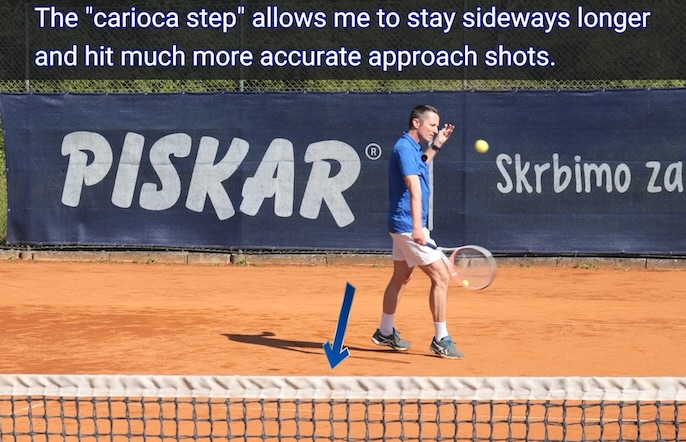
The "carioca" step allows us to keep the hips and the body longer sideways while hitting the ball.
So in short, do not just rush and charge to the net as fast as you can because you will not hit accurate approach shots, but rather take care of aligning your body and feet into the more effective footwork patterns that help you move quickly towards the net and hit more accurate shots.
4. Best Shot Timing When Hitting Approach Shots
There’s another very important aspect of approach shots that we need to cover if you want to win a lot of points by forcing errors and finishing points with easy volleys.
And that’s the topic of when to hit the incoming ball, in other words, how to time your approach shot.
There are three options you have:
- hitting the ball on the way down
- hitting the ball on the rise
- and hitting the ball on top of the bounce
Let’s take a look at the pros and cons of each situation and what it means to you in terms of risks.
a) Hitting the Ball On The Way Down
If you wait for the ball to start falling down after the bounce, you will have the most time to set up and the most time to really see the ball well.
That will allow you to hit a really clean and controlled shot, and therefore your risk of missing the shot will be very low.

The approach shot is very safe and controlled but you may be too far from the net when opponent attempts their pass.
But the disadvantage of waiting for the ball and hitting it on the way down is that you’ll be further away from the net, and you most likely will not come close enough to the net as you approach, and that makes it easy for your opponent to pass you or to force you to hit a weak volley.
b) Hitting The Ball On The Rise
If you want to hit the ball on the rise and approach the net, then you’ll have to really rush towards it before it reaches the peak of its flight, and in most cases, you will have the time to control your footwork, nor will you be able to see the ball well.
And so in most cases, you will not hit the ball clean, nor will you have good control of the shot, so there will be a high risk of missing the shot.
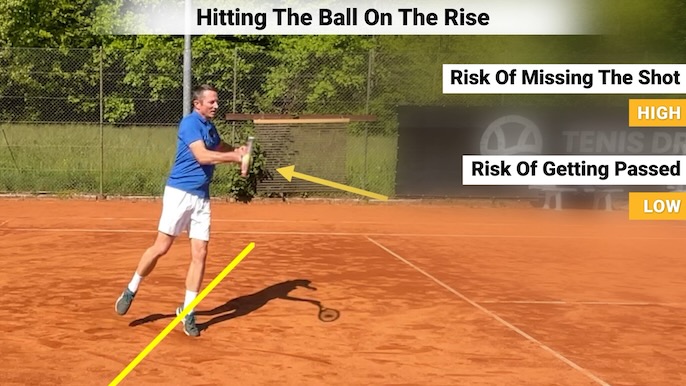
The only way you can get away with hitting the ball on the rise is if you just push the ball in the court.
The only “pro” in this situation is that if you do manage to hit the ball in the court, you will put your opponent under time pressure and likely force an error or an easy ball to put away.
c) Hitting On Top Of The Bounce
When you attempt to hit the ball on top of the bounce, you get the best of both worlds.
You will still see the ball quite well after the bounce and be able to align your body and feet into the right position so that you can hit accurately and with good power.

You need to move quickly but not rushed to get the ball on top of the bounce.
At the same time, you will be more inside the court and be able to get quite close to the net with your approach to cut off the angles of your opponent’s passing shots.
Summary
When you’re looking to master your tennis approach shots, whether on the backhand or the forehand side, you have to work on 4 key elements: tactics, technique, footwork, and timing.
Here is a quick overview of what to focus on in your next on-court sessions:
- Tactics - approach mostly with down-the-line shots and aim into around a 2-meter / 6-feet wide area.
- Technique - focus on grazing the ball when hitting topspin shots so that your shots still retain a good amount of pace and yet have some topspin on it, which allows you to control the ball well.
- Footwork - a neutral stance on both forehand and backhand sides is better for accuracy, but be flexible to use an open stance on higher balls. Use the carioca step on backhand slice approach shots for better shot accuracy.
- Timing - the best timing to hit the ball is to hit it on top of the bounce. That gives you enough time to position and see the ball well and still come very close to the net after your approach shot to cover the net well against potential passing shots.
The ball is in your court now! If there's something else you want to know when it comes to approach shots in tennis, let me know in the comments below!


